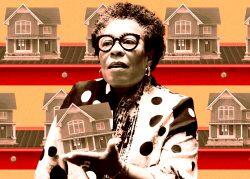Washington, D.C., is ready for its close-up.
D.C. may be the nation’s capital, but its housing market has long trailed other East Coast and even West Coast markets.
The District is a fixed, finite space that can’t grow vertically thanks to The Height of Buildings Act of 1910. As for demand, well, there’s no major reality series documenting attractive, wealthy people living here. Even the various scripted shows based in the nation’s capital — like “The West Wing,” “House of Cards” and “Veep” — were filmed just about everywhere except inside the city limits.
Despite its importance on the world stage, it’s rarely said in the same breath as New York or Miami when it comes to real estate.
“We always like to say — you know for the longest time — [D.C.] is undervalued in the sense of being the capital of a country,” Robert Hryniewicki of HRL Partners, which is under the Washington Fine Properties umbrella, said. “If you look at other capitals of the world — whether it’s Paris or London or Berlin — the cost of living compared to the rest of the country is very expensive.”
Researchers and market experts often use words like, “moderate” and “stable” to describe D.C.’s housing market. The metro is rarely on the top of the booming market rankings, but it’s also never on any lists of “over-inflated” or “juiced-up” markets.
But now D.C.’s days in the shadows are over, says Hryniewicki.
“It was all fueled, really, by the pandemic,” he says, “but we’re starting to see that appreciation.”
“It’s a market that’s a big, powerful small town,” is how Tom Anderson, president of Washington Fine Properties describes it. “D.C.’s become a well-recognized luxury market. … We’ve owned our company here for 25 years, the market and the price points have been going up and up.”
Read more



It seems the capital city’s food scene, nightlife and free — that’s right, free — museums are finally paying off as more people without professional ties to the city are choosing to live in the District, he adds.
At the end of the day, the center of the D.C. market is its rich and powerful residents.
Though she’s likely sold it, former House Speaker Nancy Pelosi (CA-12) owned a multimillion-dollar condo on Georgetown’s waterfront. The building was one of the first luxury condominiums in D.C. on the waterfront.
“With the exception of that one building on Georgetown’s harbor, you really didn’t have any luxury waterfront in D.C. proper,” says Jason Mendel, an associate broker with Washington Fine Properties. “If you look at any other big metropolitan area, the highest price points are on the water.”
Mendel began his career in D.C. real estate 17 years ago at the time when Logan Circle and the 14th Street Corridor began their transformations.
“There were a lot of clear heels on 14th street back in those days,” he says. “But now it’s impossible to get a table at [French restaurant] Le Diplomate.”
Washington Fine Properties has an office across the street from Le Diplomate and frequently takes clients there. The popularity of ‘Le Dip’ among D.C.’s movers and shakers is no surprise. During the Trump Administration, EPA Administrator Scott Pruitt allegedly requested his driver use an emergency siren and flashing lights to clear 14th Street traffic so he could get to the Parisian-style restaurant sooner.
Meanwhile, The Wharf and Navy Yard only shot up as luxury markets within the last decade. Not only do some of the buildings in these neighborhoods boast views of the river, but they’re super convenient for anyone commuting to Capitol Hill *hint-hint* *wink-wink*.
At one point, Navy Yard had a reputation for being a ‘bubble’ for Trump’s younger staffers. Today, it’s become popular with what Mendel calls “celebrity political figures” on the left side of the aisle. It’s well known in the District that Rep. Alexandria Ocasio-Cortez (NY- 14) rents a luxury apartment in Navy Yard, as does Transportation Secretary Pete Buttigeg with his husband, Chasten. The two have been seen together chatting at the dog park.
“He’s here all the time, you know, managing his department,” says Mendel, adding that elected representatives, on the other hand, have obligations to their constituencies across the country.
The growth along D.C.’s waterfront has not been without controversy. Living in Navy Yard, which boomed following the construction of the National’s Stadium, is often stigmatized for being a monument to gentrification.
While discussing her new digs in an interview on Showtime’s “Desus & Mero,” AOC asked her hosts “am I a gentrifier?” to which The Kid Mero said, “No! You moved from the Bronx to D.C. You’re like, the anti-gentrifier.”
“It’s not like you’re just living there, wearing Lululemons and riding a Peloton,” Nice said.
The nation’s capital still has a lot of growing to do if it wants to compete with New York or Miami, and that growth is going to continue along the waterfront.
“I think, if we had a time machine to go 10 years in the future, we’d be saying Anacostia [as the next Navy Yard for investors],” Mendel said. “I think Anacostia is gonna be like how Brooklyn is now to Manhattan.”
Like the saying, “you can’t make an omelet without cracking a few eggs,” you can’t turn your city into a mega-market without some controversy. As of 2010, Anacostia’s population is 92 percent African-American and many of the families have been in the neighborhood for generations, according to the U.S. Census Bureau.
“There’s sensitivity,” says Mendel. “[Long-term residents] don’t want the taxes to go out of control and that’s important but I think there are big opportunities to come to Anacostia.”
